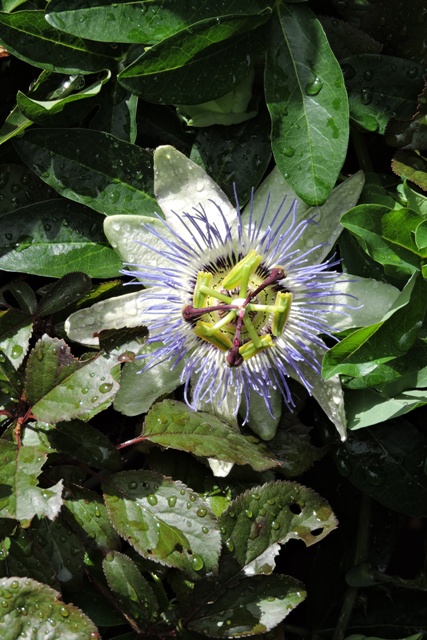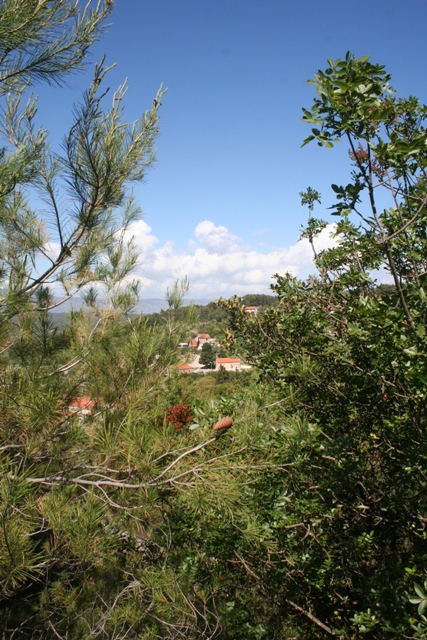Up with the sun
This week: Up with the sun; Diverting the rain; Insect life; Party time; Looking back;

We have had some much needed and most welcome rain this week. I have recorded over 22 mm in total so a little under an inch.
This does mean that with everything being wet, it has curtailed a lot of my outside activity. I just no longer find working in the wet to be that much fun!
On the plus side, I have not needed to irrigate the summer salad leaves that I planted last month.
They are growing extremely well and all have survived. Several have “bolted” and are now in flower.
I will be collecting seeds from them in due course.
Of the remainder, I have been cutting some every day to have in sandwiches and as salads.
After the rain, there are some lovely images to record of sunshine on wet flowers and leaves.

Up with the sun
I was looking at the forecast for the week ahead last Sunday morning. It suggested that from Wednesday we would have rain.
That was a good forecast, because we desperately need rain, but it also meant that all outside work would be limited, so my plans for the weeks were adjusted accordingly.
On Monday morning I was outside as the sun came up over the hill called Hum to the east of Dol.

The official time of sunrise is at 05:35, but it is almost 45 minutes later when the sun actually appears over the hills.
I had noticed that the Ivy, which grows up the north facing wall of the Konoba had really spread quickly this spring.

I cut the Ivy down last summer leaving the stems to die on the wall so no further damage was caused.
But the growing conditions this spring have been excellent – for things like Ivy – with light moisture and a cool, late spring, followed by warming sunshine.
This is the outside wall of the Konoba. The inside is damp and there are traces of roots which have come all the way through the lime mortar of the 1 metre thick walls.


In the past I have never actually removed all of the Ivy, just severing the stems and cutting it back to prevent growth up the walls.
This time because the roots go into the base of the stones, I have treated them with a systemic weed killer.

Ivy is an invasive climber, with modified roots at nodules on the stems that worm their way into any fissure, crack or crevice and then the roots both expand and corkscrew to hold the plant in place.
These stem roots cause significant damage to old walls, and doesn’t do a lot for new walls either. An Ivy covered wall may look nice, but it causes major damage to the fabric of the building.
By coffee time, I had completely cleared the Ivy back and removed an old chicken hatching +
frame that had been on the wall.

What I have discovered is that there seems to be the remains of three buildings that had been well hidden under all the greenery.
There is the massive base of a wall which my architect thinks was the original building. On the inside of the Konoba this is about a metre below soil level.
This bottom wall has then been built on and a layer of concrete poured on the top in an attempt to keep the elements out of the stonework underneath.
This primary outside wall is set back from what are essentially the building’s original foundations. Finally the existing wall of the upper floor of my building has been built on this and set back again.

Talking to Cvjetko he thinks that to make the inside of the building completely damp proof, I will have to dig down the outside wall to expose the stonework and it will have to be sealed against moisture from the outside.
However that is going to be a job for another day!
Diverting the rain
Very much allied to the prevention of moisture getting into the Konoba, I have adjusted the down pipe from the roof on this side of the building as well this week.
When I moved in, there was not a single piece of guttering anywhere, on any building. Slowly but surely I have added galvanised guttering to the eaves of all the roofs.
There were marks on the walls where the rain had for decades, just cascaded off the tiles and run down the walls underneath.
I harvest all the rainfall I can and direct it to where I need it in the orchards.
Following the workshop being built last year, I had moved the fall pipe to the farthest corner of the building, but when we were digging out the floor of the Konoba before laying the concrete, this corner was especially damp.
My suspicion is that the rain from this roof has been seeping into the Konoba. Water will always find its way to the lowest level. Because the floor is more than a metre below ground level, it is not surprising it is damp.
The pitched roof that this fall pipe drains covers 25 m². So the amount of water entering the fall pipe equates to 25 litres of water for every millimetre of rain which falls and hits the pitch on this side of the building.
That is a lot of water. This week it will have handled 550 litres.
Think of a standard watering can which usually holds six litres and it is just over four full cans for every millimetre of rain.
I needed to move the supporting bracket for the fall pipe, cut off a bit the the pipe which was too long and then attach a 75 mm diameter plastic pipe to move the water away.
I still need to connect this up to the drain which runs into the top orchard, but until then, rain will at least be several meters away from the damp corner in the Konoba.
Insect life
There are good insects and bad insects.
Let me start with the bad insects. They are the ones which choose to feed on some of my nicest plants, whether as caterpillars or the considerably smaller, almost invisible and often more damaging Aphids.
The good insects are ones which eat the bad insects!
OK, I am simplifying things here. There are pretty insects like this Swallowtail butterfly which I found resting on a weed in the orchard this week.

A little later I came across this newly hatched nymph of a Katydid. It is barely a centimetre long from nose to tail.

It will moult several times until reaching adult size, when it will have a body length of three centimetres.
While I have this diversity of insect life, I know that my stewardship of the land is working.
This week the Wild Gladioli, Gladiolus illyricus have begun to flower. I have been encouraging them to flower and spread and it seems to be working.

Something else in flower this week are my dessert olives. I planted two trees five years ago and this is the first year that they have flowered.

The flowers on olive trees are diminutive plain green spheres, which are easily missed.
I have seen other trees which people have planted locally and they began to fuit much sooner, to the point I wondered if I was doing something wrong.
It is nice to see that my patience has been rewarded and I should be able to harvest my own fruit come November.
Party time
Even during the pandemic vestiges of normal life remain.
My immediate neighbour has had builders in remodelling a patio and outdoor eating area next to his home. The work was finished this week, despite the rain.
On Saturday afternoon he celebrated with a roast lamb. All the team were invited.

The new roof is built of substantial timbers supported by four corner posts and then tiled with traditional tiles. It provides a light and airy dining area.
The opportunity was also taken to reduce the height of the large Oak tree at the back. It has been reduced to the height of the house, a reduction of around six metres. This will mean that there will be more winter sunshine because of the reduced canopy.
After the meal there were traditional folk songs.

This party did mean that it was after 8 in the evening when I got home, and hence why this week’s blog is a little delayed. NCG
Looking back – Week 19
This is the start of a new weekly section, with links to past issues of the blog.
2015/19 Let sleeping cats lie

2016/19 Timing is everything

2017/19 Boxing clever

2018/19 My local soundscape

2019/19 What to do when it’s wet outside

2020/19 Running…..

2 Responses
Marcy
A beautiful and interesting blog as usual. Really enjoyed it. Thank you for sharing. Marcy
Nikola Radic
Hello Norman,
thank you very much for keeping us in touch with the things happening in Dol.
Greetings to your immediate neighbours.
Nino